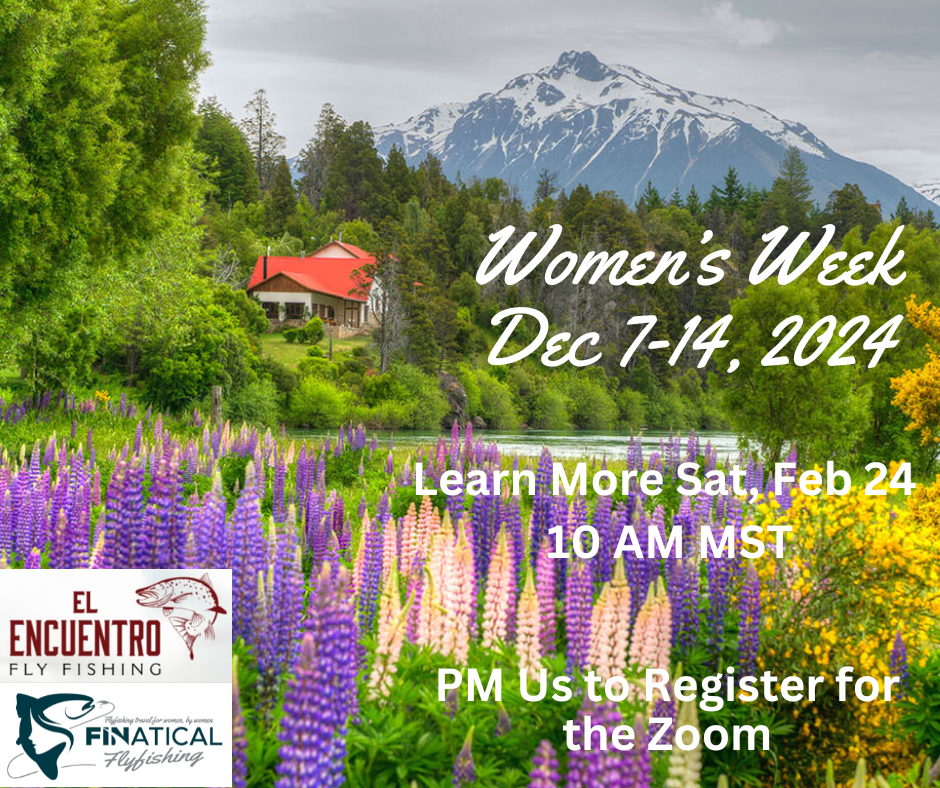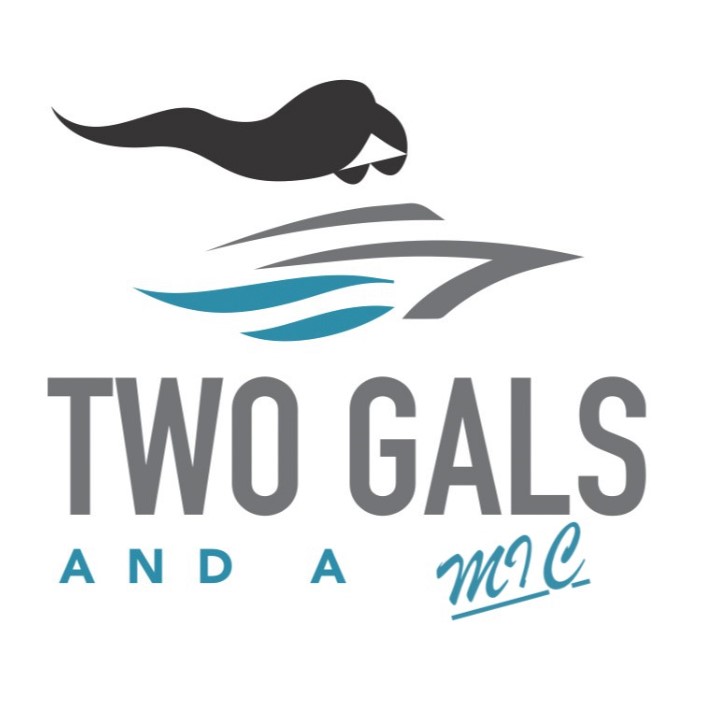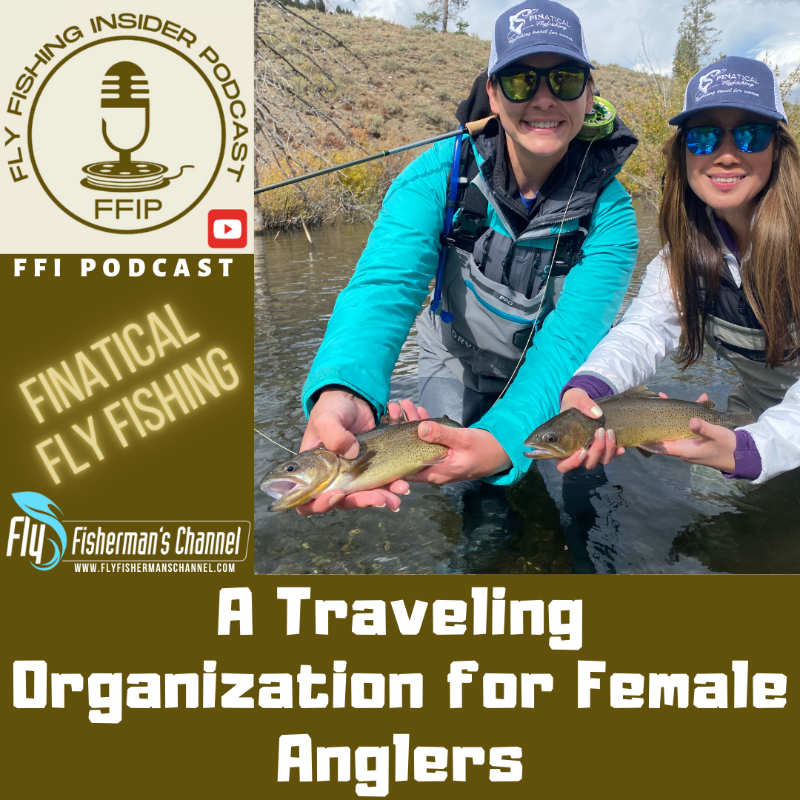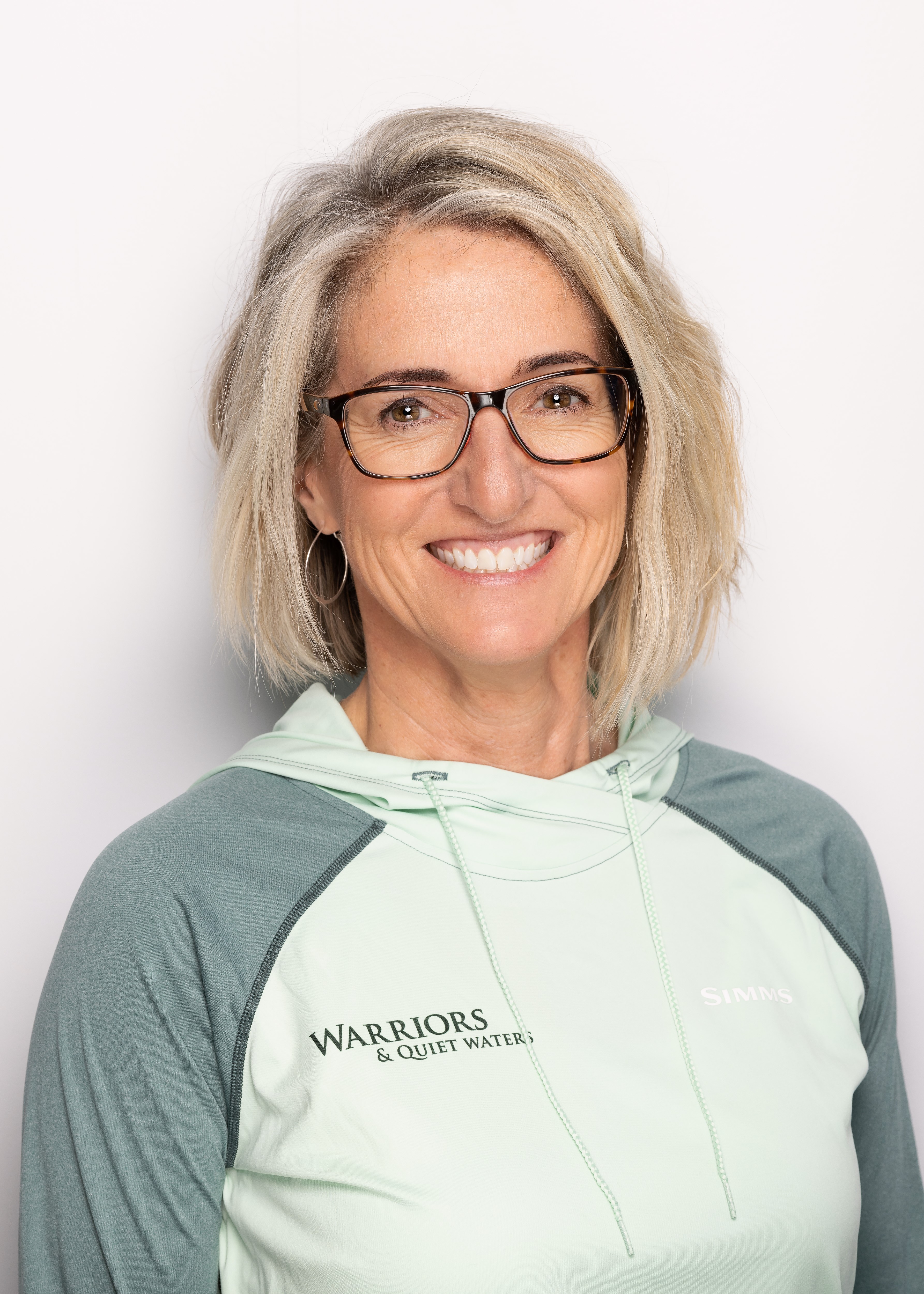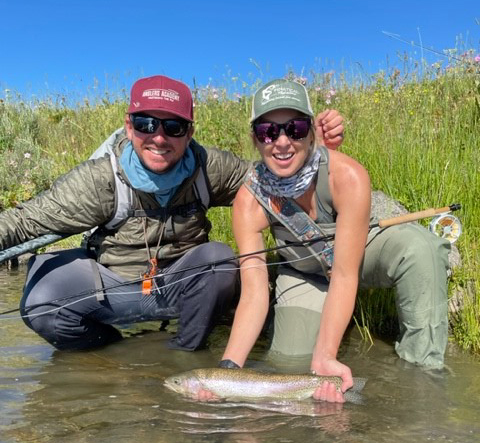Finatical Flyfishing was created to give women more choices for flyfishing travel, an opportunity to meet other women who fly fish and the chance to escape the rest of life and enjoy time on the water. Since the beginning, Finatical Flyfishing has enjoyed featuring women who are leading in the sport and the industry as examples for us all to learn from.
We are honored and excited to feature Diane Bristol, Vice President, Culture and Community at Simms. It was a pleasure to have some time to learn from Diane about all things flyfishing, career and life.
How did you get started with Simms and how did your career advance?
In 1988, Diane’s then fiancé moved to Jackson Hole after finishing college. Diane joined him in Jackson as an, “after college before we start our adult lives” adventure. She got a job with Life-Link, which was the parent company of Simms at that time. They stayed in Jackson from 1988-1991 and loved all of the skiing, hiking, biking, and of course the fly-fishing in Jackson. Diane learned about Simms and enjoyed being a part of the Simms/Life-Link team.
However, Jackson, WY was and still is an incredibly expensive place to live and they chose to move to Bozeman, Montana in 1991. Because Life-Link had their operations in Bozeman, Diane was able to continue working at Life-Link and the move to Bozeman was a great stepping-stone for the next phase of her journey. It turned out to be pivotal in her career with Simms.
In 1993 K.C. Walsh bought Simms from Life-Link and Diane was one of the 17 team members from Life-Link that became Simms Fishing Products. The bulk of the employees were in manufacturing - they were making waders, vests and other layers in Bozeman. Diane was the sole customer service person and then managed customer service and other customer-facing departments for the company as they grew. Simms further growth offered Diane the opportunity to focus solely on marketing and she ended up leading marketing and brand management until 2014 when she was invited to lead what is now People, Culture and Community.
Can you share some moments from your marketing career that were most influential in change at Simms?
“In 2000 we did a brand makeover. Dan Bryant was the creative director and did a great job, but the focus groups and some internal feedback signaled this was a big change. It was provocative, a significant difference in our marketing and brand presentation. Before this we used colorful imagery with perfect fishing conditions in our marketing. With the makeover, we began featuring professional fly-fishing guides fishing in harsh conditions with ad copy like ‘rain delays are for baseball’ and introduced the tag line ‘Choice of Professional Guides Worldwide’. Focus groups looked at the black and white images with the large orange color blocks, and they were skeptical. This brand shift set us apart in the fly-fishing industry. It influenced our products - the technical aspect, innovation, and the demand for quality and durability that could withstand the day-to-day use that guides expected. It also had an important impact on our culture, in a really positive way. People wanted to be part of this evolution. It was a big moment, and it propelled us forward on a tremendous growth path.”
“We included some female guides in our ads but the stark brand campaigns with the black and white imagery and a move away from sunny days and beautiful fishing settings didn’t connect with women anglers at that time. We believed that women’s participation in the sport would continue to grow and the focus on women’s technical product was a no brainer. We continued to evaluate and tweak our marketing approach to connect to a broader market. One of the early examples of “test and learn” was our partnership with River’s Edge, a local Bozeman fly shop, before they were owned by Simms. When they hired Sarah Clark to join their retail staff, we partnered to create an event for women that would educate them about the fly shop, to become more comfortable in the store, be more familiar with the products, and inspire them to get out on the water. This event was launched as Celebrating Women Who Love to Fly Fish. At those events, we avoided traditional fly shop activities, like Demo Days. We wanted the event to be inviting, fun and welcoming. We held scavenger hunts in the fly shop and other events that helped women understand that the fly shop was completely accessible to them.” The name eventually changed to Chico de Mayo and continued to grow. Another more recent name change to Women Are Fly, gives more options to expand beyond a single event and is accessible to other Simms retailers. The event has included female guides and instructors, speakers from Casting for Recovery, regional conservation experts, fashion shows as a way for the attendees to see women’s fly-fishing products on women (not mannequins), and a host of other creative activities to educate and engage women. It should also be noted that the event has been replicated in Denver and other locations in an effort to promote women in fly fishing.”
We’d like to note here that Diane is excited about the evolution of this event. Not only has it provided women with a fun environment for skills and product education, it’s a platform for women to connect locally and across the country, build awareness, raise funds for Casting for Recovery and present regional conservation issues and initiatives. She is grateful that this is now a sustainable event that will continue to create opportunities for women to be comfortable in the sport and promote organizations like Casting for Recovery that give so much back to women through fly-fishing.
Have there been difficult times in the Simms journey that you could share with us as inspiration?
“Initially I think there was resistance to believing that women would ever become an important part of the market share in fly fishing. It was hard to convince some shop owners they should invest in this segment. I wish there wasn’t a continual conversation about the opportunity. It’s so much better, but it pains me when I hear from women about negative fly shop experiences. That’s why I’m so happy to see growth in women guides/outfitters and more ambassadors to push retailers to be relevant in the women’s market,” said Diane.
“Other difficult times were around our growth spurts. Those times required that our entire team be ‘all hands-on deck’. For example, the trade show planning and execution was all managed by a small internal team. We would load the U-Haul, drive to a show (like the Denver Fly Fishing Show), unload the booth, set it up, work the show, pack it up, drive home, put it all away, and follow up on whatever leads you found at the show. It was physically and mentally exhausting, but those moments also created the best opportunities to build relationships and bond as a team – they were culture building. There were so many occasions to learn and grow. They also launched friendships that remain today.”
What is it like to be a woman ‘in a man’s industry’?
“Early on in my career there were times that were hard. When I was ‘the customer service department’ at Simms I would be asked ‘Can you put a man on the phone?’, I would laugh to myself and think, well there are 17 people in the company and there isn’t anyone else in customer service…so no.”
“Today there are more women in the fishing business and industry, so it’s evolved. I love going to the shows – trade or consumer – and seeing the diversity of the audience. It’s baby steps, for sure, but I am the eternal optimist. I think all of us have probably had the experience where a boatful of guys float by and one will say ‘nice cast’. Hmm…..would they say that to a guy if he were fishing here? And no, I don’t need help getting the boat in the water. Thanks, though.”
It is exciting to have so many women in the industry, leading, setting examples and creating great environments. We all adapt and make the most of every situation presented to us. It’s wonderful to have peers to connect with and find opportunities to work together to engage more women in the sport.
What significant changes have you seen in the industry?
More women owning fly shops, obtaining outfitters licenses, manufacturing women’s products, and creating resources for women in flyfishing. There are a lot of clubs and volunteer experiences available to all of us.
What insight can you share with us as to the future of women’s products in flyfishing?
“When any company’s R&D department looks at a new product it becomes a ‘cart before the horse question’. How much demand will there be? For example, if a small number of anglers want bootfoot waders, should we produce them? How much can we invest at every level to satisfy all demand?
Simms will continue to be focused on getting consumer insights to help inform what is needed in the market. The number of female ambassadors is growing and will continue to contribute toward product development and new product introductions.”
Do you have a favorite place to fish or species to fish for?
Diane loves adventure. During team meetings at Simms or other organizations, there is usually an ice breaker question. In a recent meeting, the question was ‘which do you pick: the beach or skiing?’. Her answer… neither! She wants to fish. She loves the adventure of a saltwater experience as much as fishing on the Gallatin River. She and her husband recently bought a home near a section of the Gallatin she had not previously spent much time on. “There may not be the biggest fish or the most fish in this section…”, …but she clearly loves just being out on the water and enjoying the sport. “This home water has brought many opportunities to enjoy fishing, and all of the additional experiences fly fishing brings to us. Sometimes I have as many river rocks in my pack as the number of flies I lost that day!”
How did you get into Flyfishing?
“I grew up with a brother and Dad who liked to fish. There were a lot of fishing trips that I wasn’t invited on but we also did family camping trips and they were always near a lake or river. My brother and I would fish with a bobber and a worm, and I would generally out-fish him. When I was in about the 6th grade, my brother found an old automatic fly reel/rod combo at my Grandpas, I was really curious, but I didn’t have a lot of time on the river. When I moved to Jackson, my husband and I became friends with a lot of the fishing guides and spent a good bit of time with them on the water. When we moved to Bozeman, fishing was our weekend activity. Once our son was born in 1994, floating the river was a great way to be outside having fun and everything was contained in the boat. I’m grateful that it’s an activity that has provided so many amazing fishing adventures with my husband and son. I have also met great friends through women’s flyfishing events who love the experiences as much as I do.”
In April Diane will join five other ladies on a flyfishing adventure in Scotland. This event was planned by a friend she met at an International Women’s Flyfishing Festival in Vermont about twenty years ago. The two longtime friends have fished together near each other’s homes and several places in between. “You meet the most incredible people through the sport. Friendships, journeys, and trips blossom from there.”
What would you say to women who are new to the sport but would like to start flyfishing?
“Connect online or with groups in your area or check out a local fishing event – like a fly-fishing show or fly shop event. Admittedly, this might be easier in the Rockies than some other parts of the country. There are so many flyfishing clubs, volunteer opportunities and other events out there. Make the connection and allow those folks to help you in your journey.”
“It is helpful to book a female guide for a day on the water or connect with other women anglers locally. Ladies that have this experience most often have a great time and come back for additional flyfishing opportunities. They grow in the sport. This might mean you need to take a trip to a fly-fishing destination, but the connection with other women is powerful. It ends up being a magical, fun time and will inspire you to take the next step forward.”
What would you say to women who fly-fish but want to take it to the next level?
Volunteer in any of the many great flyfishing organizations out there. Casting for Recovery, a Trout Unlimited Chapter, Veterans organizations…. There is a long list of folks who would benefit from your time and assistance and these experiences help you build your network, gain fishing knowledge, and figure out where you can best offer more to others. For example, Casting for Recovery has more than 1,800 volunteers across the country. They inspire the retreat participants as well as those who volunteer at every event. The experiences you’ll have will bring more to you personally than just the fly fishing and networking. Your niche in the industry will become apparent.
Another route is to find a role in a fly shop. I know several women that followed this path and are now professional fishing guides, fly shop owners or now work in conservation. It’s a bit of a leap, but it’s also a great opportunity to grow yourself and provide input/insights to the shop staff that could better serve the women’s fly-fishing community.
What would you say to women who fly-fish and want to find a career at Simms or a similar company?
“Pursue the career goals that are a match to your talents. The roles Simms needs to have filled are the same roles other companies need to fill to help their companies grow and succeed. Whether it is in finance, HR, marketing or another area in business, a strong resume is key. Having a passion for flyfishing and the outdoors will certainly come up in an interview at Simms. Showing that you are well rounded from a career basis and the rest of your life makes you a great asset to the team.”
What other aspects of flyfishing do you enjoy and want to share with our audience?
“Volunteering is a wonderful experience and it’s so appreciated by the non-profit organizations. You don’t have to be a guide or a ‘professional’. There are so many ways to give back. Volunteering will give you a chance to see all it brings to life in health, joy, and mental well-being; and it is a day well spent. Friendships and connections blossom and your life will be richer because of a day spent on the water giving to others.”
Are there any benefits of flyfishing you’d like to share?
“The adventures on the water will connect you to some of the most incredible people. You meet people from all walks of life; they become great mentors, teachers, and friends. People like Rene and Bonnie Harrop, some of the best fly anglers, fly tyers and teachers in the industry, and two of the most humble and kind people you’ll meet on the river. Joan Wulff is another example of a lovely, amazing person who has contributed so much to the industry and would do anything to help you develop your fly-fishing skills – a hint here, a casting tip there. You have the opportunity to connect with a diverse group of people along your fly-fishing journey that will change your life and perspective in more ways than you can ever imagine.”

